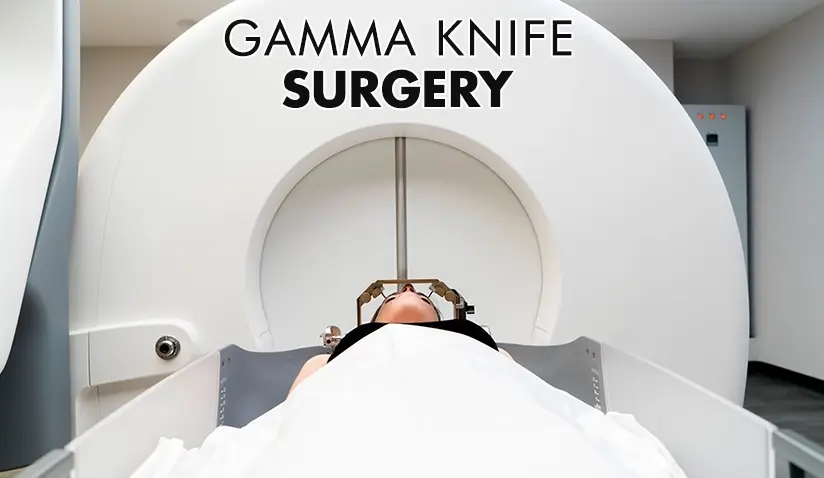Gamma Knife Surgery: What Can It Treat Besides Brain Tumors?

Updated 22 July 2024
Gamma knife surgery, a type of stereotactic radiosurgery, utilizes highly focused beams of radiation to treat various conditions in the brain. Unlike traditional surgery, gamma knife surgery is known to penetrate the brain tissue without the need for incisions. Instead, it delivers a precise dose of radiation to the targeted area of the brain while sparing the surrounding healthy tissue. Gamma knife surgery is usually performed on an outpatient basis, taking a few hours to complete, with most patients getting back to normal activities within a day or two.[1]
This futuristic, potentially life-saving therapy is best known for treating brain tumors. However, brain tumors are not the only thing it can treat. The below article covers what gamma knife surgery is, how it works, and who is eligible for treatment aside from those with brain cancer.
How Does Gamma Knife Surgery Work?
Gamma knife surgery works by using a device called a gamma knife machine, which consists of a helmet-like frame that holds hundreds of tiny radiation sources. The frame is attached to the patient’s head using four metal pins that penetrate the skin. The patient then undergoes a magnetic resonance imaging (MRI) scan to map the brain in detail and identify the location of the condition to be treated. The MRI scan is used to plan the treatment and determine the exact dose and direction of the radiation beams.
The patient is then moved to the treatment room, where the frame is attached to a movable couch that slides into the gamma knife machine. During the procedure, the patient stays awake and alert but may receive a sedative to help them relax. The gamma knife machine then delivers radiation beams to the targeted area of the brain. Treatment can involve a single session or span multiple sessions, depending on the size and shape of the area needing treatment. The radiation beams converge at a single point, creating a high dose of radiation that destroys the abnormal cells or blood vessels while minimizing damage to normal tissue.
The Benefits of Gamma Knife Surgery
Gamma knife surgery has several benefits over traditional surgery, such as:
- It is minimally invasive and does not require any incisions.
- It is associated with fewer risks and complications, such as bleeding, infection, or damage to healthy brain tissue.
- The recovery time is shorter and has less of an impact on the patient’s quality of life.
- It can treat conditions that are difficult or impossible to reach with conventional surgery, such as deep-seated or multiple brain lesions.
- It can complement other treatments, such as traditional surgery, chemotherapy, or medication regimens.
What Are the Risks Associated With Gamma Knife Surgery?
Gamma knife surgery is generally safe and well-tolerated by most patients, but it may have some risks or side effects, including:
- Pain, discomfort, swelling, bruising, or infection at the site of the pin insertion or frame attachment.
- Headache, nausea, vomiting, dizziness, or fatigue after the procedure.
- Hair loss or skin irritation in the area exposed to radiation.
In rare cases, treatment may induce tumors, malignancies, or neurological changes that may be permanent or temporary, such as vision loss, hearing loss, speech impairment, memory loss, or cognitive impairment. These side effects are usually less frequent in those opting for gamma knife surgery than other types of radiosurgery.[2]
The potential risks and side effects involved may vary depending on the type and location of the condition being treated, the dose and duration of radiation exposure, and the patient’s overall health and medical history. Therefore, it is important to consult your doctor about the potential benefits and risks of gamma knife surgery and make an informed decision before undergoing the procedure.
Lesser-Known Conditions That Can Be Treated with Gamma Knife Surgery
Besides brain tumors, gamma knife surgery can also potentially treat other conditions that affect the brain or its blood vessels and neurons. Some of these conditions are:
- Autism
Although unconventional, there has been exploratory research into the potential use of Gamma Knife Surgery for autism. Gamma knife surgery targets specific neural pathways associated with autistic behaviors, potentially modifying neural activity to alleviate symptoms.[3] According to research, patients with Autism Spectrum Disorder (ASD) experienced a significant reduction in symptoms, although maintaining this improvement required more than one treatment session. Following the lesioning procedures, all patients exhibited marked improvements in behavior, quality of life, and their ability to interact with their environment. Notably, no long-lasting side effects were observed.[4]
- Functional Disorders
Conditions that affect the function of the brain without causing any structural damage are medically referred to as functional disorders. These include tremors, Parkinson’s disease, epilepsy, and obsessive-compulsive disorder. Gamma knife surgery can treat functional disorders[5] by creating lesions in specific brain areas linked to the disorder, such as the thalamus, the subthalamic nucleus, or the anterior cingulate cortex. This may help alleviate symptoms or their severity.
Treatment for Parkinson’s tremors targets the thalamus, a brain region involved in motor control. This can reduce tremor severity[6], provide symptom relief, and improve patients' quality of life.
For certain types of epilepsy, especially when seizures originate from a specific brain area, Gamma Knife Surgery can target the epileptogenic zone, reducing the frequency and severity of seizures by disrupting abnormal electrical activity. However, according to some studies, this procedure might have some potential side effects.[7]
In cases of severe, treatment-resistant OCD, the procedure targets specific brain regions involved, potentially altering neural circuits to reduce compulsive behaviors and obsessive thoughts.[8]
Gamma Knife Surgery has also shown promise in treating various neuropsychiatric disorders, including major depressive disorder and anorexia nervosa, by targeting specific brain areas implicated in these disorders and modulating neural activity to improve symptoms. [9]
- Metastatic Tumors
Metastatic tumors are cancerous growths that spread from the initial cancer site to other areas, such as the lung, breast, colon, or skin. They can cause symptoms like headaches, seizures, nausea, vomiting, confusion, or weakness. Gamma knife surgery can treat metastatic tumors[10] by delivering a high dose of radiation that dissolves each tumor while sparing the surrounding normal tissue.
- Arteriovenous Malformations
This condition refers to abnormal connections between arteries and veins in the brain that negatively impact cerebral blood circulation. Arteriovenous Malformations (AVMs) can cause bleeding in the brain (hemorrhage), seizures, headaches, or neurological deficits. Gamma knife surgery can shrink or obliterate AVMs[11] by blocking their blood flow and preventing them from bleeding.
- Trigeminal Neuralgia
Trigeminal Neuralgia (TN) is a chronic pain syndrome involving one or more branches of the cranial nerve responsible for facial sensation and movement (the trigeminal nerve). It causes sudden episodes of intense pain on one side of the face that can be triggered by touch, chewing, talking, or brushing teeth. Gamma knife surgery can relieve TN pain[12] by damaging the nerve root where it exits from the brainstem.
- Hemifacial Spasm
Hemifacial spasms, characterized by involuntary muscle contractions on one side of the face, can be effectively treated with Gamma Knife Surgery. This procedure, which is being studied and not yet extensively used, targets the facial nerve root, reducing the nerve's hyperactivity and providing long-term relief from spasms.[13]
- Vestibular Schwannomas (Acoustic Neuromas)
Acoustic Neuromas are benign tumors growing on the vestibulocochlear nerve. Also termed the auditory vestibular nerve, this cranial nerve links the inner ear to the brain and controls hearing and balance. Acoustic neuromas can cause hearing loss, tinnitus (ringing in the ear), vertigo (dizziness), facial numbness, or facial weakness. Gamma knife surgery can stop the growth of vestibular schwannomas, also known as acoustic neuromas, or shrink them[14] by damaging their cells. The procedure delivers precise radiation to the tumor, inhibiting its growth and preserving surrounding healthy tissue, which can help maintain hearing and balance functions. [15]
- Glomus Jugulare and Tympanicum Tumors
These tumors, located near the ear and base of the skull, can cause hearing loss and other neurological symptoms. Gamma Knife Surgery targets these tumors with precision, reducing their size and alleviating symptoms without the risks associated with open surgery.[16]
- Cranial Nerve Disorders
These are conditions that affect one or more of the 12 pairs of nerves that emerge from the base of the brain and control various functions such as vision, smell, hearing, taste, facial expression, swallowing, speech, or eye movement. Cranial nerve disorders can cause symptoms such as double vision, drooping eyelids, facial paralysis, loss of smell, loss of taste, or difficulty swallowing.
Gamma knife surgery can treat cranial nerve disorders such as oculomotor nerve palsy (weakness of eye muscles) or facial nerve palsy (weakness of facial muscles). It achieves this by blocking nerve transmission, shrinking or destroying faulty nerves, or removing growths that may be causing symptoms.
- Pain Relief
Gamma knife surgery can also be utilized for relieving severe chronic pain[17] that does not respond to other treatments, such as medication, surgery, or nerve blocks. Gamma knife surgery can target pain pathways in the brain or the spinal cord and disrupt the transmission of pain signals. It has been successful in treating chronic pain conditions such as cancer-related pain, phantom limb pain, postherpetic neuralgia (pain after shingles), or trigeminal neuralgia.
Other Conditions Treated With Gamma Knife Surgery
Besides the lesser-known but significant indications mentioned above, Gamma knife surgery has proven beneficial for treating the following conditions:
- Rathke’s Cleft Cysts
Rathke’s cleft cysts are benign sellar or suprasellar lesions that can cause hormonal imbalances and vision problems. Gamma Knife Surgery focuses precise radiation beams on the cyst, reducing its size and alleviating symptoms without the need for invasive surgery. [18]
- Klippel-Trenaunay-Weber Syndrome
This rare congenital disorder involves abnormal blood vessels, soft tissues, and bones. Gamma Knife Surgery can be used to manage cerebral arteriovenous malformations associated with this syndrome by delivering targeted radiation to the abnormal vessels, causing them to shrink and reducing related symptoms. [19]
- Cushing’s Disease
For those with persistent or recurrent Cushing’s disease after surgery, Gamma Knife Surgery provides an effective treatment option. Gamma knife surgery targets the residual pituitary adenoma, reducing hormone production and helping to manage the disease. [20]
- Cavernous Sinus Hemangiomas
Cavernous sinus hemangiomas, though rare, can cause significant neurological symptoms. Gamma Knife Surgery delivers focused radiation to the hemangioma, reducing its size and alleviating pressure on surrounding structures. [21]
- Refractory Glossopharyngeal Neuralgia
For patients suffering from refractory glossopharyngeal neuralgia, a condition characterized by severe throat pain, Gamma Knife Surgery provides a viable treatment alternative. The focused radiation targets the glossopharyngeal nerve, disrupting pain signals and providing relief. [22]
- Pituitary Adenomas
Gamma Knife Surgery is highly effective in treating pituitary adenomas, particularly those that are hormone-secreting. By targeting the adenoma with precise radiation, Gamma knife surgery reduces the tumor size and hormone secretion, minimizing the need for traditional surgical interventions.[23]
Conclusion
Gamma knife surgery is a minimally invasive radiosurgical procedure that can be employed to treat a variety of conditions in the brain aside from brain tumors, such as arteriovenous malformations, trigeminal neuralgia, acoustic neuromas, tremors, Parkinson’s disease, chronic pain, and cranial nerve disorders. The procedure is a subject of active research and development, with new indications such as autism and OCD being explored. The treatment is a safe and effective option for many people and may replace traditional surgery in the future in suitable scenarios. If you are considering gamma knife surgery, talk to your doctor to learn more about the procedure and whether it is right for you.

Dr. Roberto Martínez Álvarez is the Head of the Radiosurgery and Functional Neurosurgery Unit at Ruber Internacional Hospital from Quirónsalud Hospital Group, bringing with him over 30 years of expertise in Radiosurgery and Functional Neurosurgery.
He is widely recognized for his proficiency in radiosurgery utilizing Gamma Knife technology, with over 6,500 successful treatments conducted at Ruber International Hospital since 1993. Dr. Martínez’s expertise and extensive experience in this field underscore his significant contributions to advancing patient care and treatment outcomes in neurosurgery.

Hospital Ruber Internacional from Quirónsalud Hospital Group is a leading private hospital in Madrid, Spain, known for its top specialists, advanced technology, focus on innovation and commitment to continual advancement in healthcare. The hospital offers cutting-edge treatments in various specialties, such as cancer, cardiovascular, and neurological conditions.
The addition of the latest Da Vinci robotic system model "xi" has further enhanced surgical precision and expanded treatment capabilities across various specialties, establishing Hospital Ruber Internacional's position as a global leader in healthcare innovation and patient care.
Sources:
Featured Blogs



